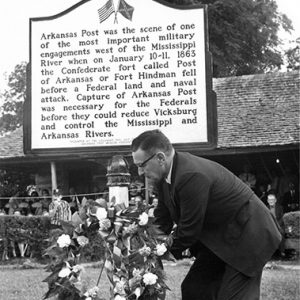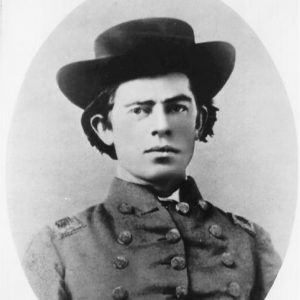calsfoundation@cals.org
Civil War Centennial
As the nation approached the 100th anniversary of the Civil War in 1961, Arkansas also prepared to commemorate the events of those horrific years. Advance preparation began in 1959, with the legislature’s creation of the Civil War Centennial Commission (CWCC) of Arkansas, with Sam D. Dickinson as chairman. The CWCC coordinated Little Rock (Pulaski County) events with the Arkansas Commemorative Commission (later the Old State House Commission), headed by chairman Dr. D. D. McBrien of Henderson State Teachers College (now Henderson State University), with Agnes Loewer as executive director. These commissions also worked with state, city, and community organizations to coordinate and advertise programs across the state to commemorate Arkansas’s part in the Civil War.
On August 27, 1960, the CWCC of Arkansas announced the commemorative plans of the following cities: Prairie Grove (Washington County), Camden (Ouachita County), Washington (Hempstead County), Sheridan (Grant County), Hot Springs (Garland County), Helena (Phillips County), Fort Smith (Sebastian County), Lake Village (Chicot County), Pine Bluff (Jefferson County), and Little Rock. More specifically, Little Rock planned for reenactments of the Secession Convention at the Old State House and the capture of the Little Rock Arsenal, as well as a Civil War gun display at the arsenal and a Negro Activities Committee to encourage interest in the part African Americans had played in the war. Two bus tours of Arkansas Civil War sites were planned, one for state educators and the other for visitors. Also preparatory to the coming centennial was the Old State House’s opening of a gallery of Arkansas Civil War battle flags. The U.S. government had returned nine of these state infantry banners to Arkansas during the administration of Governor Jeff Davis in 1905. They were kept in a bank vault for many years.
Nationally, on January 8, 1961, President Dwight D. Eisenhower opened the four years of commemorations with a national proclamation and with solemn ceremonies held at the tombs of Civil War generals Ulysses S. Grant and Robert E. Lee. Eisenhower requested church bells to be rung across the nation to mark the beginning of the national commemorations. Arkansas’s official participation began on the following day, as several dozen women of the United Daughters of the Confederacy (UDC) met to lay a wreath at David O. Dodd’s grave in Little Rock’s Mount Holly Cemetery.
The first major program of celebration in Arkansas was the reenactment of Arkansas’s secession vote held on the lawn of the Old State House on May 6. Members of the legislature read from the original transcripts the words of the men who a century earlier had voted to lead Arkansas out of the Union.
The events of the day were capped with the state’s official Centennial Costume Ball at the Marion Hotel. Governor Orval Faubus and his wife led the Grand March of invited officials and dignitaries into the ballroom. Members of the governor’s party arrived at the Marion by carriage, riding from the Governor’s Mansion. The women dressed in period gowns and the men in period attire or uniforms. Music was also of the Civil War era. Members of the Daughters and Sons of the Confederacy provided decorations and refreshments. The ball was invitation only, with attendees making a $5 donation to the CWCC’s Memorial Markers Fund.
Beginning in 1962, the Arkansas Civil War Centennial Commission sponsored the placing of a series of historical markers throughout the state commemorating significant events. The first year, historic markers were erected to commemorate the engagements at Cane Hill (Washington County) and St. Charles (Arkansas County). In 1963, markers were placed at Pitman’s Ferry in Randolph County, Center Point (Howard County), and several sites in Helena. In 1964, one marker was dedicated at the site of the Engagement at Poison Spring and a second one at Center Point. The last year of the commemoration, 1965, saw markers raised at Jacksonport (Jackson County) and Helena. The CWCC also sponsored the publication of two books about the Civil War in Arkansas: Calvin L. Collier’s “They’ll do to tie to!”: The Story of the Third Regiment, Arkansas Infantry, C.S.A. (1959) and Edwin C. Bearss’s Steele’s Retreat from Camden and the Battle of Jenkins’ Ferry (1967).
While counties and communities across the state marked their involvement in the Civil War with individual events, the Arkansas Gazette’s “Chronicles of Arkansas” column by Margaret Ross compiled an impressive day-by-day, four-year record of the state’s and its citizens’ participation in the war. Otherwise, the general record holds only a few historical highlights over the following four years.
Jackson County held a special commemoration of its entry into the war on May 5, 1961, while St. Charles reenacted its battle on June 13, 1962. Prairie Grove’s reenactment was held on first weekend in September. The depiction of the Engagement at Jenkins’ Ferry was held on April 30, 1964. The Action at Fayetteville was commemorated with speeches on April 18, 1963. Little Rock’s re-creation of its fateful battle and surrender was held on September 8, 1963.
Three significant events highlighted the state’s centennial. First, Indiana returned two Arkansas infantry flags captured a century earlier. On June 6, 1962, Governor Matthew E. Welsh came to Arkansas to hand the flags to Governor Faubus, saying, “These flags are symbols of the tie that binds our states together.” Faubus said the return showed that “the conquest of good will and love is greater than the conquest of arms.” The flags were from Dobbins’s Arkansas Cavalry and the Fifteenth Northwest Arkansas Volunteers. Governor Welsh departed from Arkansas to return flags to Tennessee, Louisiana, and Mississippi. Secondly, Governor Harold Hughes of Iowa returned two flags that the Thirty-third Iowa had captured at the Battle of Helena on July 4, 1863, to the city of Helena for its July 4, 1963, centennial celebration. Lastly, 1962 witnessed the culmination of the efforts of the state’s congressional delegation to establish a Pea Ridge National Military Park in northwest Arkansas. Members of Arkansas’s congressional delegation secured passage of a bill establishing the park in 1956, and the Pea Ridge Memorial Association was founded in 1961 to oversee the details of the park’s completion. Special events were held commemorating the 100th anniversary of the battle on March 6–8, 1962, and the park was formally opened with a memorial service on March 11.
March 1964 saw the first meeting of the Civil War Roundtable of Arkansas. Jerry L. Russell was chosen as its charter president. Russell went on to be one of the nation’s most outspoken leaders for the defense and preservation of Civil War battlefields and to sponsor the creation of dozens of Civil War roundtables in Arkansas and other states.
The balls, reenactments, speeches, monument dedications, and general excitement and interest that marked the beginning of the Arkansas centennial commemoration appear to have faded by 1965. No newspaper reports were generated of any ceremonies commemorating the close of the war. A three-column article detailing Lee’s surrender, with an accompanying drawing and picture of the surrender site, did appear in the Arkansas Gazette on Sunday, April 4, 1965, the Sunday closest to the actual April 9, 1865, anniversary. The following Friday, the 100th anniversary of the Civil War’s end, Governor Faubus gave a dedication speech for the opening of the Morton frozen food plant in Russellville (Pope County).
Articles reporting events in Vietnam or civil rights activities filled the front pages of 1965 and crowded the Civil War out of print. Only Margaret Ross’s “Chronicles of Arkansas” column continued to the end and on into Reconstruction, but public events either ceased or were not deemed newsworthy.
The state legislature did make an important final gesture to the war’s memory in 1965 with Act 275, which appropriated $50,000 for the erection of a monument to commemorate the “service of Arkansas troops in the ‘Army of Northern Virginia’ who were present at the Battle of Gettysburg, July 1–13, 1863.” The Arkansas monument was dedicated on June 18, 1966.
For additional information:
“128 Pound Civil War Cannon Ball Dug Up in Yard of Old Field House.” Arkansas Gazette, March 3, 1963, p. 4A.
“2 Flags Lost in Civil War To Be Returned to Arkansas.” Arkansas Gazette, May 17, 1962, p. 16A.
Deane, Ernie. “No Rebel Yells But South Wins Fayetteville.” Arkansas Gazette, April 19, 1963, p. 1B.
Dunnahoo, Pat. “Historic Civil War Battle Has Historic Connection.” Arkansas Gazette, May 3, 1964, p. 4E.
Deane, Ernie. “Arkansas Traveler: Raiders Re-enact a Bit of History.” Arkansas Gazette, September 9, 1962, p. 5E.
“Blood-stained, Torn Civil War Banner to Hang in Glory.” Arkansas Gazette, September 29, 1960, p. 4A.
“Ceremonies Today to Open Four Year Civil War Centennial.” Arkansas Gazette, January 8, 1961, p. 10A.
“Ceremonies to Note State’s Secession from Union.” Arkansas Gazette, April 30, 1961, p. 17A.
“Civil War Centennials Set by Twelve Cities in Arkansas.” Arkansas Gazette. August 28, 1960, p. 12A.
“Flags Taken in Civil War Are Returned to Arkansas.” Arkansas Gazette, June 2, 1962, p. 1A.
“Governor Will Speak at Dedication.” Arkansas Gazette, April 9, 1965, p. 1B.
Granade, S. Ray. “Arkansas Commemorates the Civil War Centennial: An Exercise in Pragmatism.” Arkansas Historical Quarterly 73 (Winter 2014): 414–437.
“History Yields a Little Bit But General Walker ‘Dies’ as Drums Roll, Cameras Whir.” Arkansas Gazette, September 8, 1963, p. 8A.
“Iowa Will Return 2 Flags to Helena.” Arkansas Gazette, April 20, 1963, p. 3A.
“Old State House Civil War Flag Gallery Opens 1 PM Today.” Arkansas Gazette, September 15, 1960, pp. 1A, 2A, 4A.
“Omer R. Weaver Recognized as First Arkansan to be Killed in Civil War.” Arkansas Gazette, April 29, 1962, p. 6E.
“Reenactment of Secession Convention Held in Old State House.” Arkansas Gazette, May 6, 1961, p. 6A.
Ross, Margaret. “Chronicles of Arkansas.” Arkansas Gazette, 1961–1965.
Snelling, Lois. “Leetown: It Stood When the Fury of Pea Ridge Broke; Now Only an Old House Remains.” Arkansas Gazette, July 9, 1961, p. 2E.
“St. Charles Marks Centennial of Civil War Battle Sunday.” Arkansas Gazette, June 13, 1962, p. 1B.
“Summary of History of First Arkansas Infantry Regiment.” Arkansas Gazette, September 17, 1962, p. 13A.
“United Daughters of the Confederacy Lay Wreath on Grave of David Owen Dodd.” Arkansas Gazette, January 9, 1961, p. 2A.
Whitworth, Bill. “Confederates Lose Man but Refuse to Yield in 2d Battle of Little Rock.” Arkansas Gazette, September 9, 1963, pp. 1A, 2A.
Paul D. Haynie
Harding University


 Dr. Harold V. Glenn
Dr. Harold V. Glenn  Omer Rose Weaver
Omer Rose Weaver 



Comments
No comments on this entry yet.